Development of leadership competency framework for board of management members in private enterprises using a delphi method
Speaking of "business leaders", we often
think of the leader as a business owner, board
chairman or chief executive officer. However,
when the market trend is continuously
developing with new technologies and methods,
corporate governance is also changing. The role
of the board of management is growing,
critically influencing the development of the
business. The competitiveness of enterprises is
determined by the quality of the board of
management [1]. Successful businesses focus
on competency building for the board of
management in the present and future [2-4].
The period 2015-2016 marked an
international integration of Vietnam's economy
with a series of trade agreements were signed.
According to the trend of international
economic integration, business leaders need to
see their business as a "commitment" instead of
"short-lived opportunities" as before, since the
mission of the business is associated with the
management model and the execution of tasks
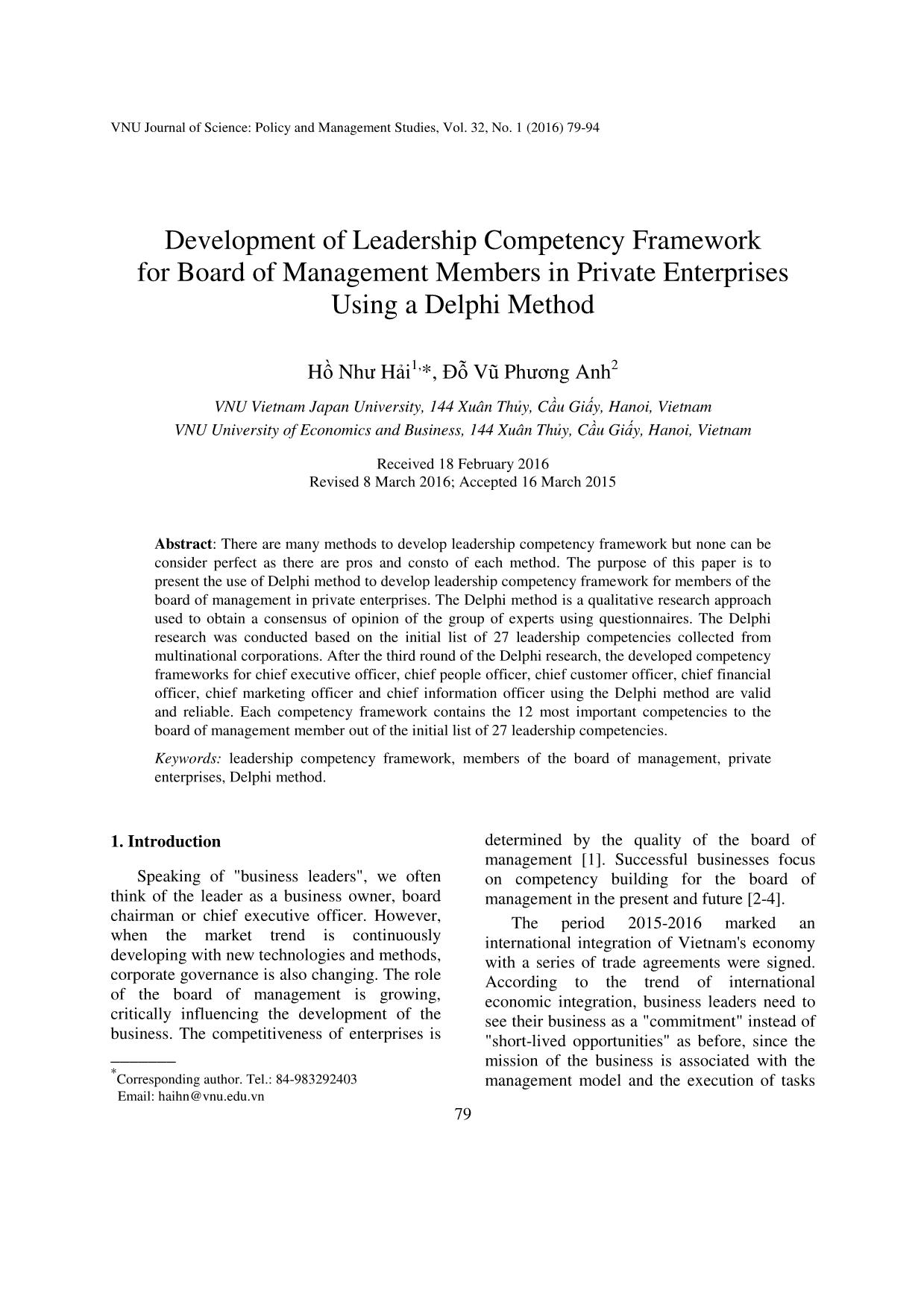
Trang 1
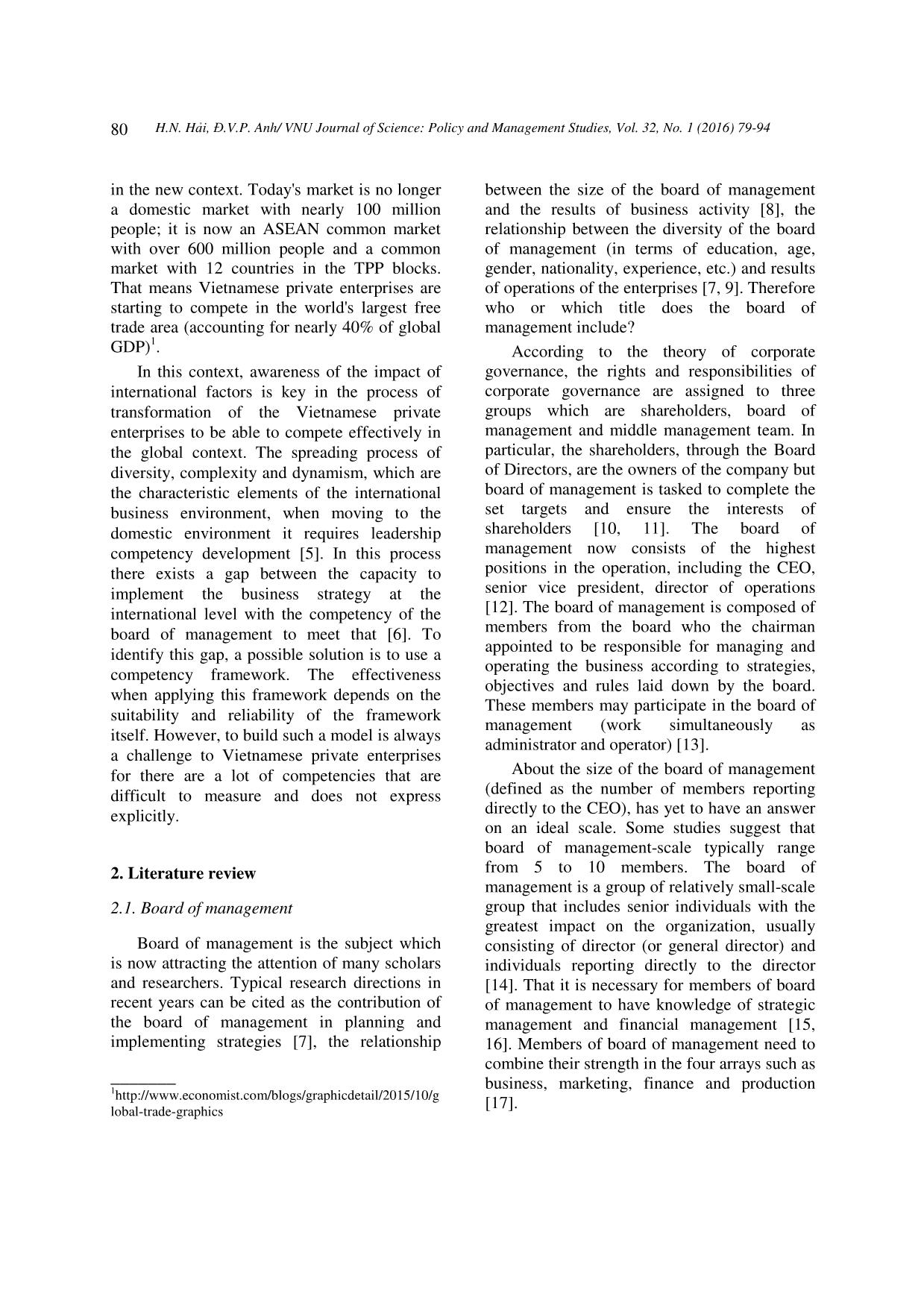
Trang 2
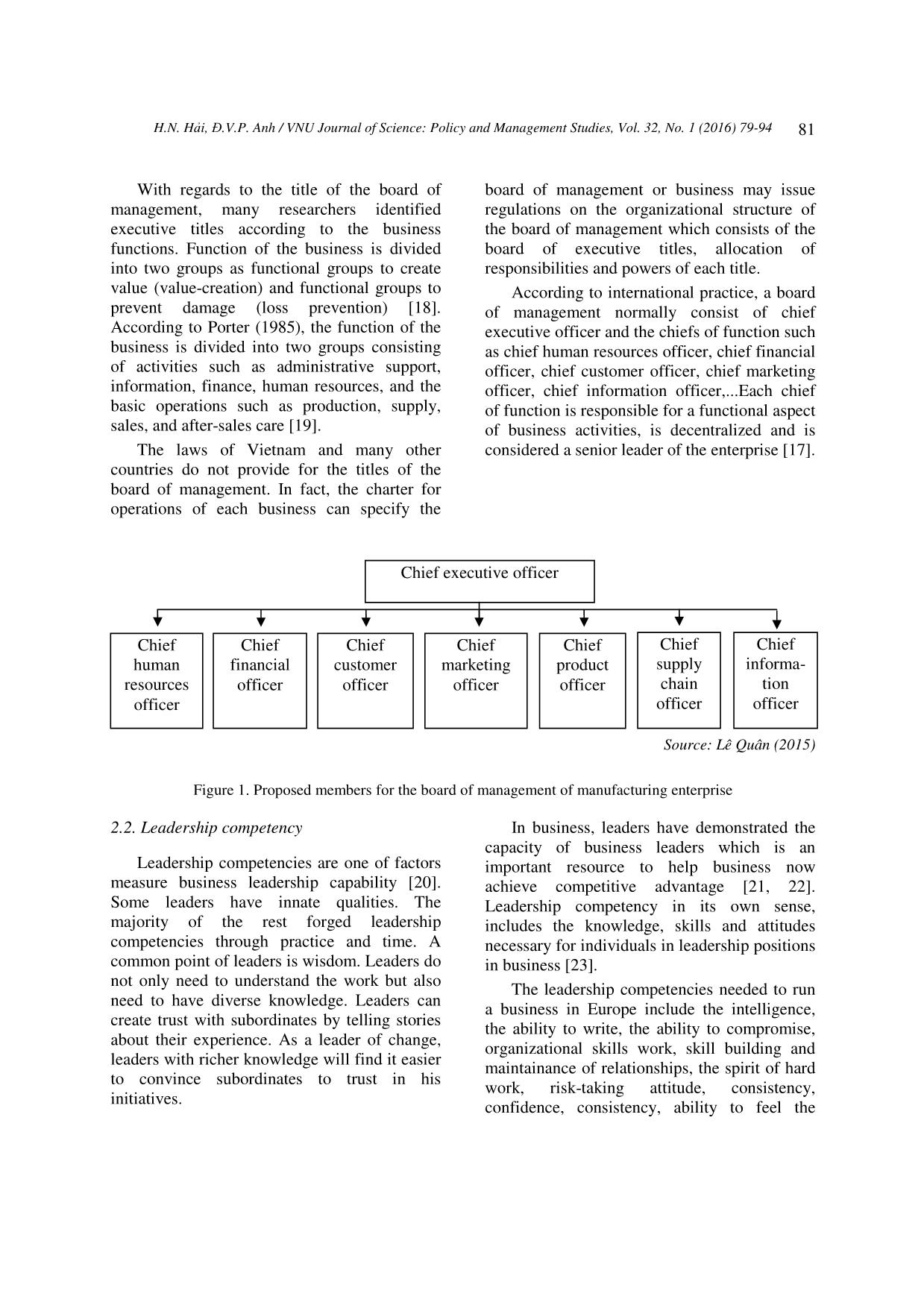
Trang 3
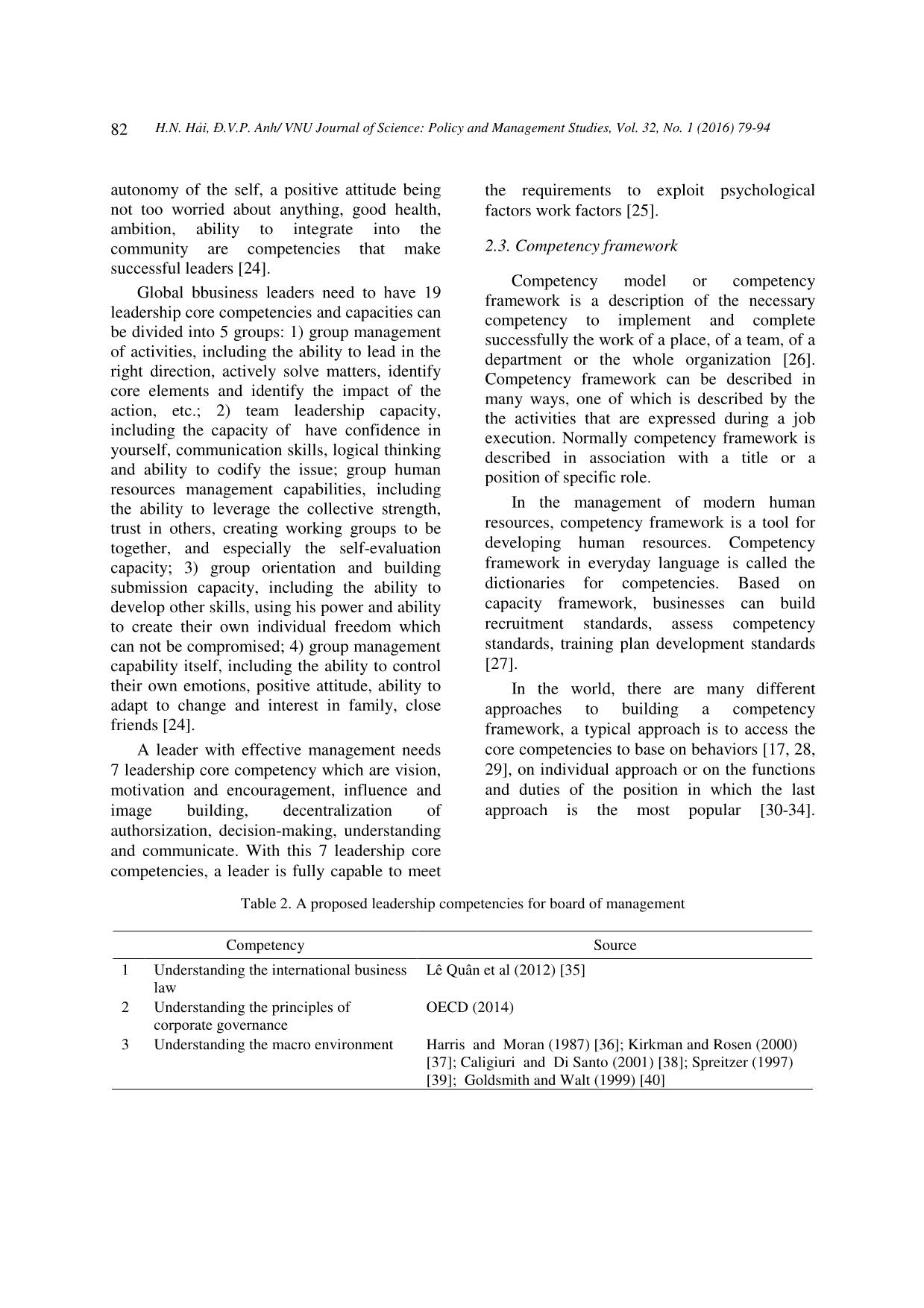
Trang 4
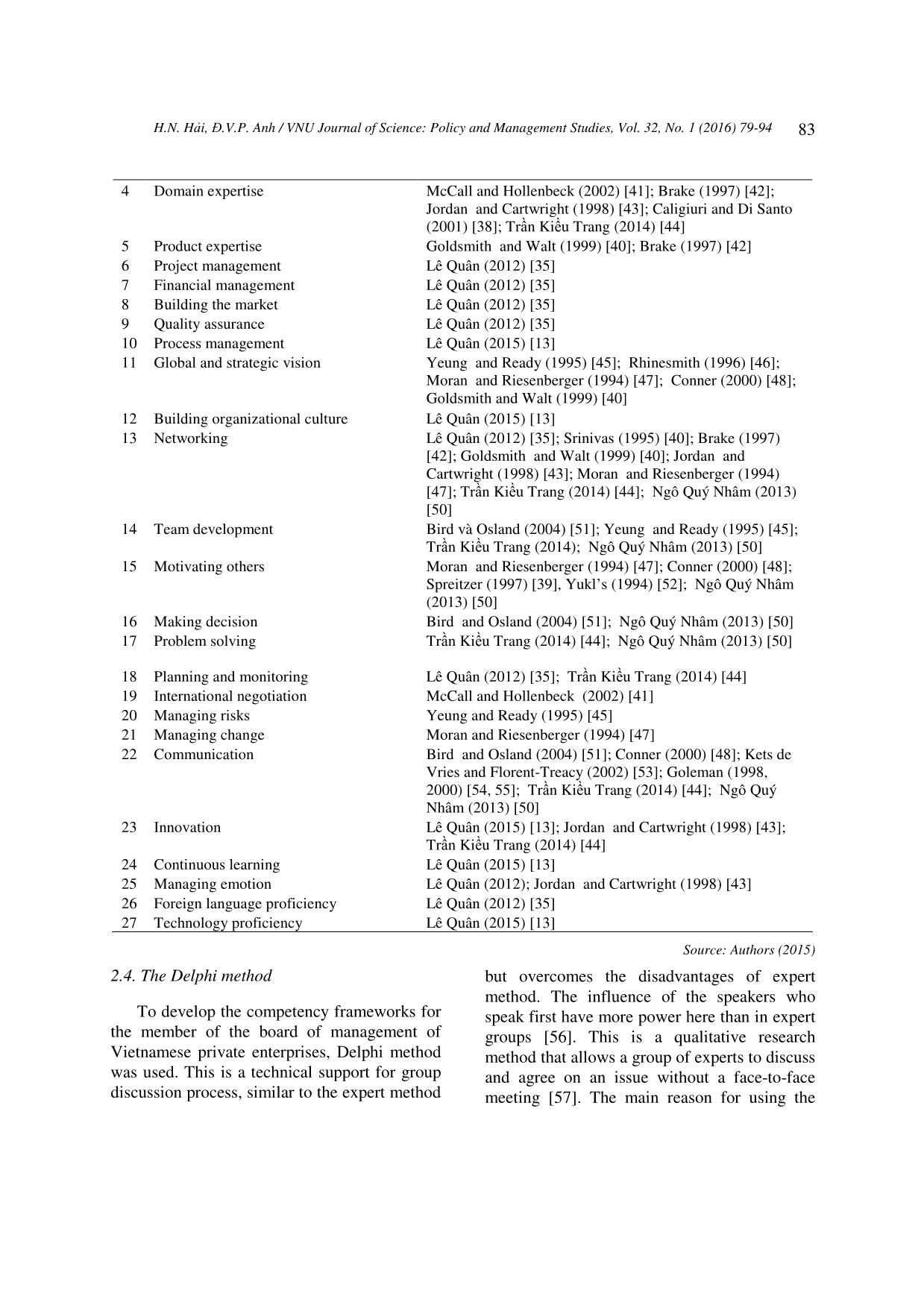
Trang 5
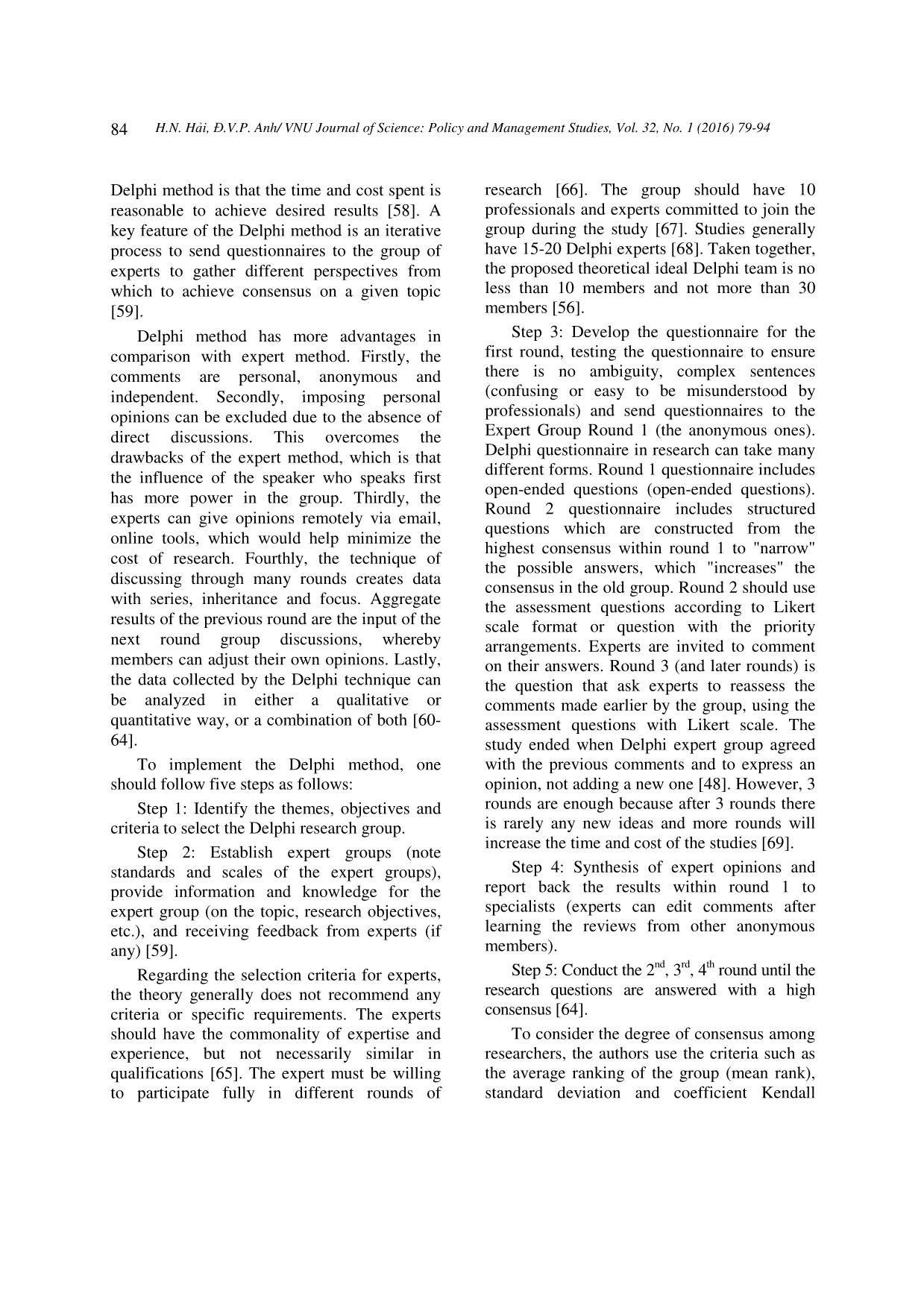
Trang 6
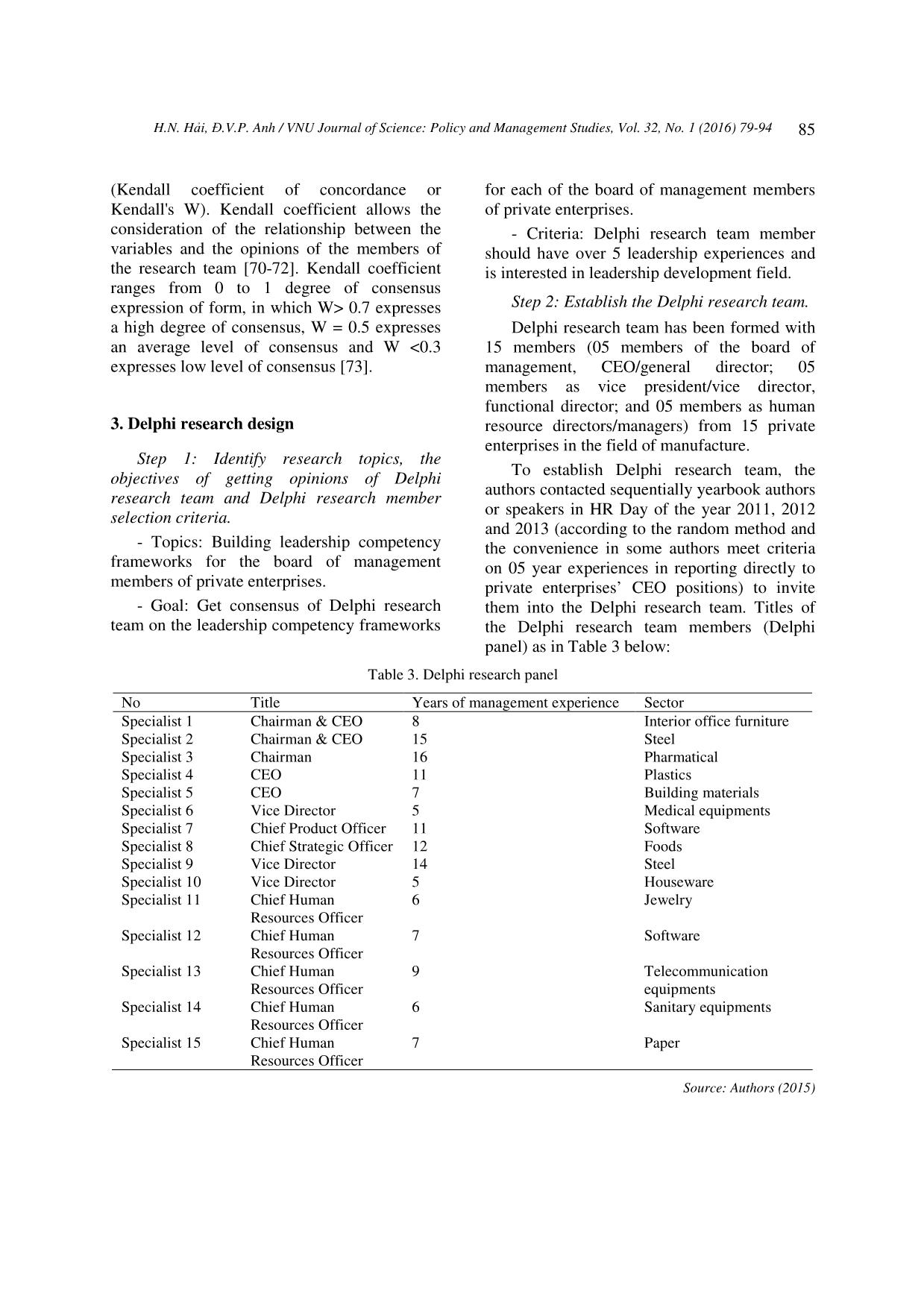
Trang 7
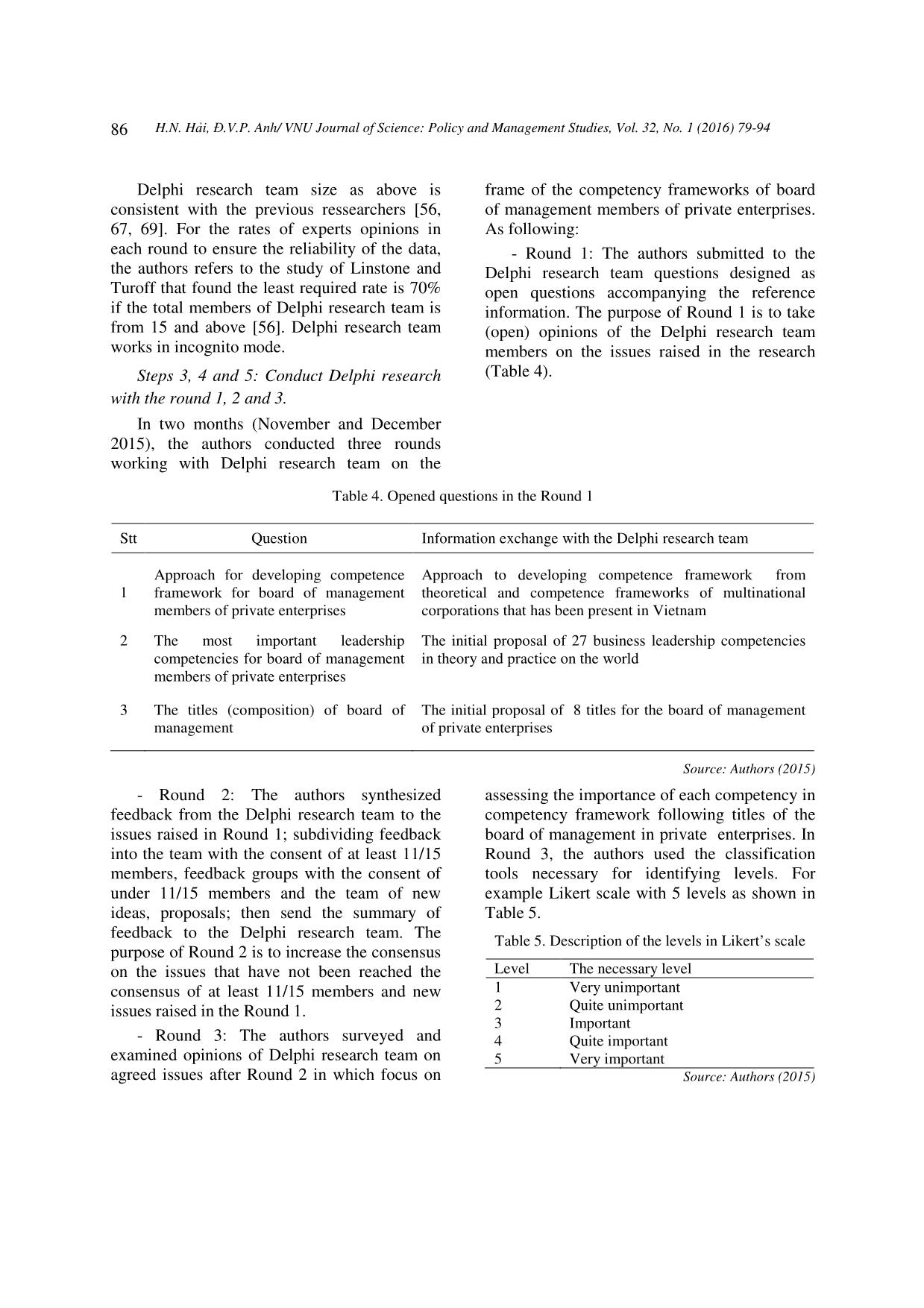
Trang 8
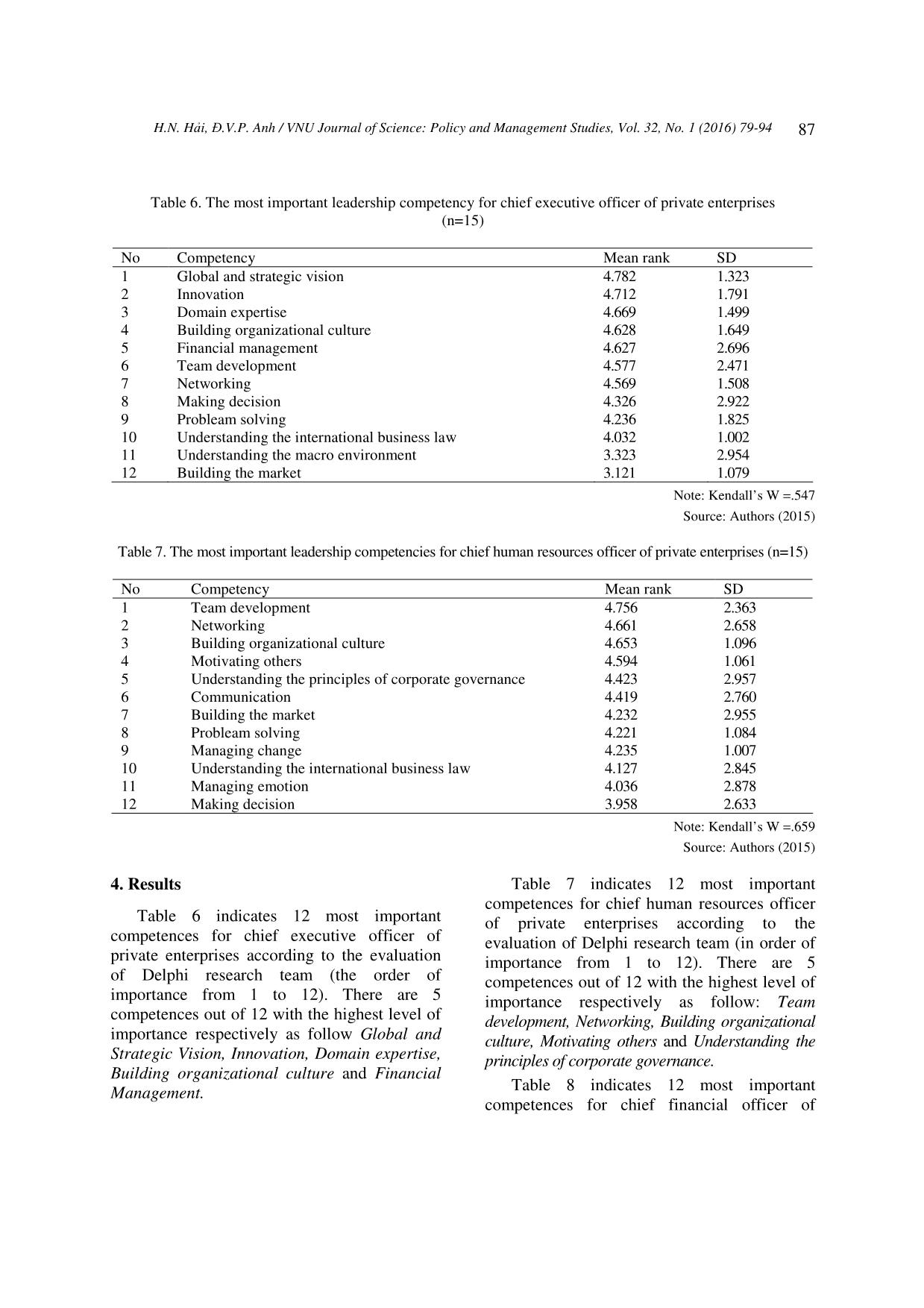
Trang 9
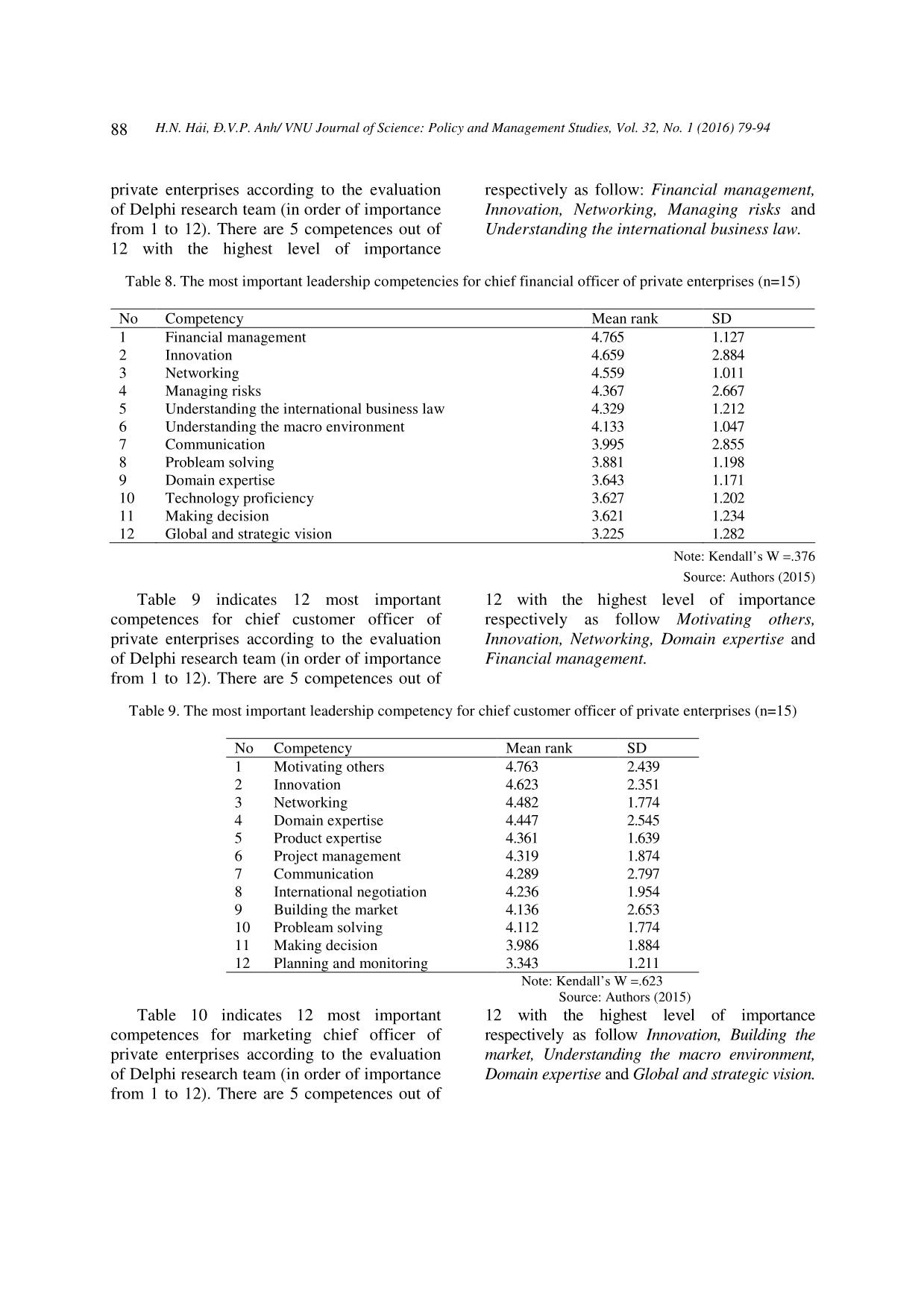
Trang 10
Tải về để xem bản đầy đủ
Tóm tắt nội dung tài liệu: Development of leadership competency framework for board of management members in private enterprises using a delphi method
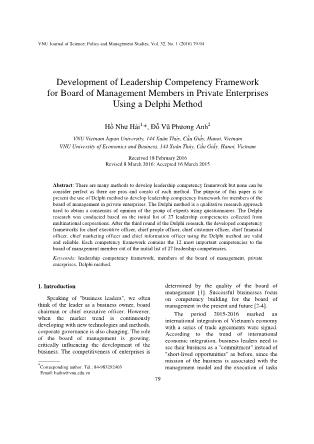
VNU Journal of Science: Policy and Management Studies, Vol. 32, No. 1 (2016) 79-94 79 Development of Leadership Competency Framework for Board of Management Members in Private Enterprises Using a Delphi Method Hồ Như Hải1,*, Đỗ Vũ Phương Anh2 VNU Vietnam Japan University, 144 Xuân Thủy, Cầu Giấy, Hanoi, Vietnam VNU University of Economics and Business, 144 Xuân Thủy, Cầu Giấy, Hanoi, Vietnam Received 18 February 2016 Revised 8 March 2016; Accepted 16 March 2015 Abstract: There are many methods to develop leadership competency framework but none can be consider perfect as there are pros and consto of each method. The purpose of this paper is to present the use of Delphi method to develop leadership competency framework for members of the board of management in private enterprises. The Delphi method is a qualitative research approach used to obtain a consensus of opinion of the group of experts using questionnaires. The Delphi research was conducted based on the initial list of 27 leadership competencies collected from multinational corporations. After the third round of the Delphi research, the developed competency frameworks for chief executive officer, chief people officer, chief customer officer, chief financial officer, chief marketing officer and chief information officer using the Delphi method are valid and reliable. Each competency framework contains the 12 most important competencies to the board of management member out of the initial list of 27 leadership competencies. Keywords: leadership competency framework, members of the board of management, private enterprises, Delphi method. 1. Introduction∗ Speaking of "business leaders", we often think of the leader as a business owner, board chairman or chief executive officer. However, when the market trend is continuously developing with new technologies and methods, corporate governance is also changing. The role of the board of management is growing, critically influencing the development of the business. The competitiveness of enterprises is _______ ∗Corresponding author. Tel.: 84-983292403 Email: haihn@vnu.edu.vn determined by the quality of the board of management [1]. Successful businesses focus on competency building for the board of management in the present and future [2-4]. The period 2015-2016 marked an international integration of Vietnam's economy with a series of trade agreements were signed. According to the trend of international economic integration, business leaders need to see their business as a "commitment" instead of "short-lived opportunities" as before, since the mission of the business is associated with the management model and the execution of tasks H.N. Hải, Đ.V.P. Anh/ VNU Journal of Science: Policy and Management Studies, Vol. 32, No. 1 (2016) 79-94 80 in the new context. Today's market is no longer a domestic market with nearly 100 million people; it is now an ASEAN common market with over 600 million people and a common market with 12 countries in the TPP blocks. That means Vietnamese private enterprises are starting to compete in the world's largest free trade area (accounting for nearly 40% of global GDP)1. In this context, awareness of the impact of international factors is key in the process of transformation of the Vietnamese private enterprises to be able to compete effectively in the global context. The spreading process of diversity, complexity and dynamism, which are the characteristic elements of the international business environment, when moving to the domestic environment it requires leadership competency development [5]. In this process there exists a gap between the capacity to implement the business strategy at the international level with the competency of the board of management to meet that [6]. To identify this gap, a possible solution is to use a competency framework. The effectiveness when applying this framework depends on the suitability and reliability of the framework itself. However, to build such a model is always a challenge to Vietnamese private enterprises for there are a lot of competencies that are difficult to measure and does not express explicitly. 2. Literature review 2.1. Board of management Board of management is the subject which is now attracting the attention of many scholars and researchers. Typical research directions in recent years can be cited as the contribution of the board of management in planning and implementing strategies [7], the relationship _______ 1 lobal-trade-graphics between the size of the board of management and the results of business activity [8], the relationship between the diversity of the board of management (in terms of education, age, gender, nationality, experience, etc.) and results of operations of the enterprises [7, 9]. Therefore who or which title ... ource: Authors (2015) 5. Conclusion By adopting Delphi methods, the authors proposed leadership competency frameworks for the board of management members in private enteprises, including chief executive officer, chief human resources officer, chief financial officer, chief customer officer, chief marketing officer, chief product officer, chief supply chain officer and chief information officer. Each competency framework contains the 12 most important competencies to the board of management member according to the point of views of Delphi research members. Some competencies appear in more than 6 out of 8 competency frameworks such as Global and strategic vision, Building the market, Domain expertise, Networking, Team H.N. Hải, Đ.V.P. Anh / VNU Journal of Science: Policy and Management Studies, Vol. 32, No. 1 (2016) 79-94 91 development and Problem solving. These competencies must be considered as core competencies of the board of management in private enterprises. Scientifically, this research has two new contributions. Firstly, the development of leadership competency framework adopting the Delphi’s method has the relevance and reliability. Secondly, the research developed competency frameworks for the board of management members of private enterprises while other previous researches focused on leadership competency framework development for a single member such as chief executive officer. This contributed to the current trend of research in team leadership. Practically, competency frameworks of the board of management members could be used as a tool to develop and implement human resource policies and leadership development programs in private enterprises. However, this research has limitations. As Delphi method was used for this research, some competency frameworks could only be applied in enterprises that have similar characteristics to the enterprises where Delphi research members manage. References [1] Waldman, D. A., Javidan, M. & Varella, P. (2004), Charismatic leadership at the strategic level: a new application of upper echelons theory, The Leadership Quarterly, 15, pp.355–380 [2] Rogers, R. W., & Smith, A. B. (2007), Finding future perfect leaders, Bridgeville, PA: Development Dimensions International [3] Campbell, M., & Smith, R. (2010), High-potential talent: A view from inside the leadership pipeline, Greensboro, NC: Center for Creative Leadership [4] Silzer, R., & Church, A. H. (2010), Identifying and assessing high-potential talent: Current organizational practices In R. Silzer & B. E. Dowell (Eds.), Strategy-driven talent management: A leadership imperative (pp. 213– 279). San Francisco, CA: Jossey–Bass [5] Harvey, M. and Buckley, R.M. (2002), Assesssing the ‘conventional wisdoms’ of management for the 21st Century organization, Organizational Dynamics, Vol. 30 No. 4, pp. 368-78 [6] Engle, A.D., Mendenhall, M.E., Powers, R.L. and Stedham, Y. (2001), Conceptualizing the global competency cube: a transnational model of human resource, paper presented at the Global Human Resource Management Conference, Barcelona, June [7] Wiersema, M.F. and Bantel, K.A. (1992), Top Management Team Demography and Corporate Strategic Change, The Academy of Management Journal, Vol. 35, No. 1, pp. 91-121 [8] Haleblian, J. and Finkelstein, F. (1993), Top Management Team Size, CEO Dominance, and Firm Performance: The Moderating Roles of Environmental Turbulence and Discretion, The Academy of Management Journal Vol. 36, No. 4, pp. 844-863 [9] Kilduff, M., Angelmar, R., & Mehra, A. (2000), Top Management-Team Diversity and Firm Performance: Examining the Role of Cognitions, Organization Science, 11 (1), 21-34 [10] Fama, E.F (1980), Agency problems and the theory of the firm, Journal of Political Economy, Chicago, v.88, n.2, p.288-307, Apr. 1980 [11] Jensen, M.; Meckling, W (1976), Theory of the firm: managerial behaviour, agency costs and ownership structure, Journal of Financial Economics, Amsterdam, v.3, n.1, p.305-360 [12] Finkelstein, S. and Hambrick, D. C (1996), Strategic Leadership: Top Executives and Their Effects on Organizations, Minneapolis-St. Paul: West Publishing Company [13] Lê Quân (2015), Lãnh đạo doanh nghiệp Việt Nam, Nhà Xuất bản ĐHQGHN, Hà Nội [14] Finkelstein, S., Hambrick, D. C., & Cannella, Jr., A. A. (2009), Strategic Leadership: Theory and Research on Executives, Top Management Teams, and Boards, New York, NY: Oxford University Press [15] Grant Thornton, (2003), International Business Owners Survey, Grant Thornton, London [16] Brennan, N. and McDermott, M., (2003), Are non-executive directors of Irish plcs independent?, Dublin [17] Alexander, N. K.; Victoria, K. (2006), Board size and composition: the main tradeoffs, Corporate Board journal, volume 2, issue 1, 2006, pp. 48 - 5 [18] Chandler, Alfred D. (1962), Strategy and Structure: Chapters in the History of the Industrial Enterprise, Cambridge: MIT Press H.N. Hải, Đ.V.P. Anh/ VNU Journal of Science: Policy and Management Studies, Vol. 32, No. 1 (2016) 79-94 92 [19] Porter, Michael E. (1985), The Competitive Advantage: Creating and Sustaining Superior Performance, New York: Free Press [20] Dai, G., Tang, K., & De Meuse, P. K. (2011), Leadership competencies across organizational levels: a test of the pipeline model, Journal of Management Development, 366-380 [21] Barney JB, and Zajac E. (1994), Competitive organizational behaviour: toward an organizationally-based theory of competitive advantage, Strategic Management Journal, Winter Special Issue 15: 5-9 [22] Hitt, M. A., Bierman, L., Shimizu, K., & Kochhar, R. (2001), Direct and Moderating Effects of Human Capital on Strategy and Performance in Professional Service Firms: A Resource-Based Perspective, Academy of Management Journal, 44(1): 13-28 [23] Chung-Herrera, B., Enz, C., & Lankau, M. (2003), Grooming future hospitality leaders: A competencies model, Cornell Hotel and Restaurant Administration Quarterly, 44, 17-25 [24] Campbell, D. T. (1963), Social attitudes and other acquired behavioral dispositions, Psychology: A study of a science (Vol. 6, pp. 94–172), New York: McGraw-Hill [25] Barrow (1977), The Variables of Leadership, Academy of Management Review, 2, 231-251 [26] Dubois DD, Rothwell WJ (2004), Competency- based Human Resource Management., Davies- Black, Palo Alto, CA [27] Horton, S. (2000), Introduction – The Competency Movement: its Origins and Impact on the Public Sector, International Journal of Public Sector Management, Vol. 13, No. 4, p. 7 – 14. [28] Cheetham, G., & Chivers, G. (1998), The reflective (and competent) practitioner, Journal of European Industrial Training, 22 (7), pp. 267-276 [29] Hodkinson, P., and Issitt, M. (1995), The Challenge of Competence, New York: Cassell, 1995 [30] Hartle, F. (1995), How to Re-engineer your Performance Management Process, London: Kogan Page [31] Boyatzis, R. E. (1982), The Competent Manager: A Model for Effective Performance, New York: Wiley [32] Spencer, L. M. & Spencer, S. M. (1993), Competence at work, New York: Wiley [33] Johnson, S. D. and Aragon, S. R. (2002), An instructional strategy framework for online learning environments, Proceedings of the Academy of Human Resource Development Conference, Honolulu, HI [34] Lynham, S. A. (2000), Theory building in the HRD profession, Human Resource Development Quarterly, 11 (2), 159-178 [35] Lê Quân và Nguyễn Quốc Khánh (2012), Đánh giá năng lực giám đốc điều hành doanh nghiệp nhỏ Việt Nam qua mô hình ASK, Tạp chí Khoa học ĐHQGHN, Kinh tế và Kinh doanh 28 (2012) p1-7 [36] Harris, P.R. and Moran, R.T. (1987), Managing Cultural Differences, 2nd ed., Gulf Publishing Company, Houston, TX [37] Kirkman, B. L., & Rosen, B. (2000), Powering up teams, Organizational Dynamics, 28(3): 48 – 66 [38] Caligiuri, P. M., & DiSanto. V. (2001), Global competence: What is it B and can it be developed through global assignments?, Human Resource Planning Journal, 34(3), 27-38 [39] Spreitzer, G.M. (1997), Toward common ground in defining empowerment, Research in Organizational Change and Development, Greenwich, CT: JAI Press [40] Goldsmith, M. and Walt, K. (1999), New competencies for tomorrow’s global leader, CMA Management, December/January, pp. 20-4 [41] McCall, M. W., & Hollenbeck, G. P. (2002), Developing global executives: The lessons of international experience, Boston, Harvard Business School Press [42] Brake, T. (1997), The Global Leader. Critical Factors for Creating The World Class Organization, Irwin Professional Publishing, Chicago, IL [43] Jordan, J. and Cartwright, S. (1998), Selecting expatriate managers: key traits and competencies, Leadership & Organization Development Journal, Vol. 19 No. 2, pp. 89-96 [44] Trần Kiều Trang (2011), Kinh nghiệm phát triển năng lực quản lý doanh nghiệp nhỏ ở một số nước trên thế giới và bài học đối với Việt Nam, Tạp chí Khoa học Thương mại, số 45, 12/2011 [45] Yeung, A. K., & Ready, D. A. (1995), Developing leadership capabilities of global corporations: A comparative study in eight nations, Human Resource Management, 34(4), 529-547 [46] Rhinesmith, S. H. (1992), Global minsets for global managers, Training & Development, October, 63-68 H.N. Hải, Đ.V.P. Anh / VNU Journal of Science: Policy and Management Studies, Vol. 32, No. 1 (2016) 79-94 93 [47] Moran, R.T. and Riesenberger, J.R. (1994), The Global Challenge: Building the New Worldwide Enterprise, McGraw-Hill Book Company, London [48] Conner, J. (2000), Developing global leaders of tomorrow, Human Resource Management, Vol. 39 Nos. 2/3, pp. 147-57 [49] Srinivas, K.M. (1995), Globalization of business and the third world: challenge of expanding the mindsets, Journal of Management Development, Vol. 14 No. 3, pp. 26-49 [50] Ngô Quý Nhâm (2012), Khung năng lực và ứng dụng trong hoạt động quản trị nhân sự, Nhà quản lý, số 94/2012, tháng 03/2012 [51] Bird A. and Osland J.S. (2004), “Global Competencies: an Introduction”, The Blackwell Handbook of Global Management: a Guide to Managing Complexity, Blackwell Publishing Ltd [52] Yukl, G. (1994), Leadership in Organizations, 3rd ed., Prentice Hall, Englewood Cliffs, NJ [53] Kets de Vries, M.F.R. and Florent-Treacy, E. (2002), Global leadership from A to Z: creating high commitment organizations, Organizational Dynamics, Vol. 295 No. 309, pp. 1-16 [54] Goleman, D. (1998), “What makes a leader”, Harvard Business Review, Vol. 76 No. 6, pp. 93- 103 [55] Goleman, D. (2000), “Leadership that gets results”, Harvard Business Review, Vol. 78 No. 2, pp. 78-89 [56] Linstone, H. A. & Turoff, M. (Eds.) (1975), The Delphi method: Techniques and applications, Massachusetts: Addison-Wesley Publishing Company [57] Goodman, C. (1987), The Delphi technique: A critique, Journal of Advanced Nursing, 12(6), 729-734 [58] Helmer, O. (1983), Looking forward: A guide to future research, Beverly Hills, CA: Sage [59] Talbot, L. (1995), Principles and practices of nursing research, St. Louis: Mosby [60] Dalkey, N.C., Rourke, D.L., Lewis, R. and Snyder, D. (1972), Studies in the Quality of Life, Delphi and Decision-Making, Messachusetts: Lexington Books [61] Loo, R. (2002), The Delphi method: a powerful tool for strategic management. Policing, An International Journal of Police Strategies & Management, 25 (4), 762-769 [62] Gatewood, R.D. and Gatewood, E.J., (1983), The use of expert data in human resource planning: guidelines from strategic forecasting, Human Resource Planning, 5(1). Pp.83-94 [63] Fowles, J., (1978), Handbook of futures research, Greenwood Press: Connecticut. [64] Skulmoski, G.J., Hartman, F.T., and Krahn, J. (2007), The delphi method for graduate research, Journal of Information Technology Education, Vol. 6 [65] Hanson, W.H., and Ramani, N. (1988), Technology forecasting: a hydroelectric company experience, Technology Management Publication, 1(3)., pp. 266-270. Harvard Business School Press [66] Hsu, C., & Sandford, B. A. (2007), The Delphi technique: Making sense of consensus. Practical Assessment, Research & Evaluation, 12(10) [67] Parente, F. J., Anderson, J. K., Myers, P., & O’Brien, T. (1994), An examination of factors contributing to Delphi accuracy, Journal of Forecasting, 3(1), 173 - 183 [68] Ludwig, B. (1997), Predicting the future: Have you considered using the Delphi methodology?, Journal of Extension, 35 (5), 1-4 [69] Altschuld, J. W. (2003), Delphi technique. Lecture, Applied evaluation design, The Ohio State University [70] Nevo, D., & Chan, Y. E. (2007), A Delphi study of knowledge management systems: Scope and requirements, Information and Management, 44, 583-597 [71] Schmidt, R., Lyytinen, K., Kiel, M. & Cule, P. (2001). Identifying software project risks: An international Delphi study, Journal of Management Information Systems, 17(4), 5-36 [72] Siegel, S., & Castellan, N. (1998), Non-parametric statistics for the behavioral sciences, New York, NY: McGraw-Hill [73] Schmidt, R. (1997). Managing Delphi surveys using non-parametric statistical techniques, Decision Sciences, 28(3), 763-774 H.N. Hải, Đ.V.P. Anh/ VNU Journal of Science: Policy and Management Studies, Vol. 32, No. 1 (2016) 79-94 94 Xây dựng khung năng lực lãnh đạo cho Ban điều hành doanh nghiệp tư nhân sử dụng phương pháp Delphi Hồ Như Hải1, Đỗ Vũ Phương Anh2 1Trường Đại học Việt Nhật, ĐHQGHN, 144 Xuân Thủy, Cầu Giấy, Hà Nội, Việt Nam 2Trường Đại học Kinh tế, ĐHQGHN, 144 Xuân Thủy, Cầu Giấy, Hà Nội, Việt Nam Tóm tắt: Có nhiều phương pháp xây dựng khung năng lực lãnh đạo nhưng không phương pháp nào là tối ưu do đều có ưu điểm và hạn chế. Bài báo này giới thiệu ứng dụng phương pháp Delphi vào nghiên cứu khung năng lực lãnh đạo của ban điều hành doanh nghiệp ngoài quốc doanh Việt Nam. Đây là một phương pháp định tính nhằm đạt được sự đồng thuận của nhóm nghiên cứu bằng cách sử dụng các bảng hỏi. Phương pháp Delphi được áp dụng kết hợp với danh mục 27 năng lực lãnh đạo doanh nghiệp được tổng hợp từ các nghiên cứu lý thuyết và thực tiễn tại một số công ty đa quốc gia. Kết quả nghiên cứu là khung năng lực của các vị trí giám đốc điều hành, giám đốc nhân sự, giám đốc tài chính, giám đốc bán hàng, giám đốc marketing và giám đốc thông tin có độ tin cậy cao. Mỗi khung năng lực gồm có 12 năng lực quan trọng nhất theo vị trí được lựa chọn từ danh mục 27 năng lực ban đầu. Từ khóa: Khung năng lực lãnh đạo, thành viên của Hội đồng quản trị, doanh nghiệp tư nhân, phương pháp Delphi.
File đính kèm:
 development_of_leadership_competency_framework_for_board_of.pdf
development_of_leadership_competency_framework_for_board_of.pdf

